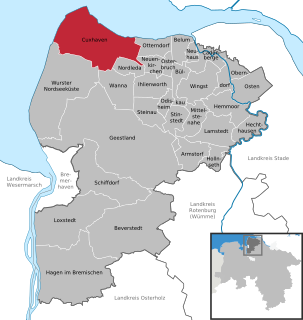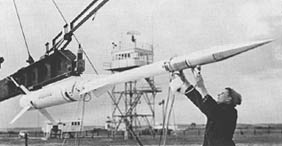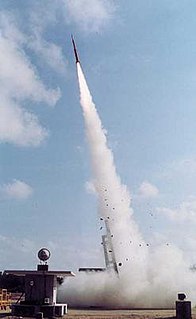
Cuxhaven is an independent town and seat of the Cuxhaven district, in Lower Saxony, Germany. The town includes the northernmost point of Lower Saxony. It is situated on the shore of the North Sea at the mouth of the Elbe River. Cuxhaven has a footprint of 14 kilometres (east–west) by 7 km (4 mi) (north–south). Its town quarters Duhnen, Döse and Sahlenburg are especially popular vacation spots on the North Sea and home to about 52,000 residents.

Soyuz TM-25 was the 30th crewed spacecraft mission to visit the Russian Space Station Mir.

Großenkneten is a municipality in the district of Oldenburg, in Lower Saxony, Germany.
The Berthold Seliger Forschungs- und Entwicklungsgesellschaft mbH (BSFEGmbH) was a company founded by German rocket technical designer Berthold Seliger in 1961. Seliger was a former assistant theoretician professor Dr. Eugen Sänger. The company developed and built prototypes of sounding rockets and launched them near Cuxhaven. The BSFEGmbH cooperated strongly with the Hermann-Oberth-Gesellschaft, of which Berthold Seliger was a member. The first rocket developed by the BSFEGmbH was an improved version of the Kumulus, which was first launched on 19 November 1962 and reached a height of 50 kilometres. On 7 February 1963 the BSFEGmbH launched a two-stage rocket with a maximum height of 80 kilometres and, on 2 May 1963, they launched a three-stage rocket with a maximum flight height of more than 100 kilometres. The latter rocket may have attained the highest flight altitude of all rockets built in post-war Germany. The signals from all these rockets were also received at the observatory in Bochum. After May 1963 the BSFEGmbH worked on the improvement of the steering system of their rockets and thought also on military usable rockets.
The Hermann Oberth Society is an association named after Hermann Oberth, the German astronautics pioneer and the authoritative expert on rocketry outside the United States, which develops and builds rockets and trains engineers in space technology.

Operation Backfire was a military scientific operation during and after the Second World War, which was performed mainly by British staff. It was part of the Allies' scramble to acquire German technology. With the consent of U.S. General Dwight D. Eisenhower, the operation was orchestrated by Major Robert Staver from the Rocket Section of the Research and Development branch of the Ordnance Office that was tasked in directing the effort to find and interrogate the German rocket specialists who had built the V-2. Since April 30 he had been in the Nordhausen area searching the smaller laboratories for V-2 technicians. Also Auxiliary Territorial Service (ATS) Junior Commander Joan Bernard played a role in this operation.
Between 1933 and 1964 numerous rocket experiments were carried out in the area of Cuxhaven, Germany.
Seliger Rocket is the designation for the sounding rockets of the Berthold Seliger Forschungs- und Entwicklungsgesellschaft mbH. They were
- A single-stage rocket with a length of 3.4 metres and a takeoff thrust of 50 kN. This rocket was first launched on November 19, 1962 near Cuxhaven and reached a height of 40 km.
- A two-stage rocket with a length of 6 metres and a takeoff thrust of 50 kN. This rocket was first launched on February 7, 1963 and reached a height of 80 km.
- A three-stage rocket with a length of 12.8 metres, a diameter of 0.56 metres and a takeoff thrust of 50 kN. This rocket was first launched on May 2, 1963 with reduced fuel and reached an altitude of 110 km. Later with maximum fuel it reached a height of 150 km.
The Mohr Rocket was a sounding rocket developed by Ernst Mohr in Wuppertal, Germany.

Nike Asp was an American sounding rocket. The Nike Asp has a ceiling of 220 km, a takeoff thrust of 217 kN, a takeoff weight of 700 kg, a diameter of 0.42 m and a length of 7.90 m.

FalconSAT is the United States Air Force Academy's small satellite engineering program. Satellites are designed, built, tested, and operated by Academy cadets. The project is administered by the USAFA Space Systems Research Center under the direction of the Department of Astronautics. Most of the cadets who work on the project are pursuing a bachelor of science degree in astronautical engineering, although students from other disciplines join the project.
The first Data-Collecting Satellite was launched on February 9, 1993. It is the first satellite developed entirely in Brazil and it remains in operation in orbit to this date. SCD-1 was designed, developed, built, and tested by Brazilian scientists, engineers, and technicians working at National Institute of Space Research and in Brazilian industries. It was made to be launched with a Brazilian rocket in 1989. Once it was officially recognized that the rocket could not be completed until many years later, SCD-1, after undergoing minor adaptations, was finally launched with a Pegasus rocket made by Orbital Sciences. The rocket was launched from a B-52 airplane while flying over the Atlantic Ocean.

Sonda is a family of Brazilian-built sounding rockets which serves as an R&D path to the VLS orbital rocket.

Renews–Cappahayden is a small fishing town on the southern shore of Newfoundland, 83 kilometres (52 mi) south of St. John's.

The Thumba Equatorial Rocket Launching Station (TERLS) is an Indian spaceport established on 21st November 1963, operated by the Indian Space Research Organisation (ISRO). It is located in Thumba, Thiruvananthapuram which is near the southern tip of mainland India, very close to earth's magnetic equator. It is currently used by ISRO for launching sounding rockets.

The Civilian Space eXploration Team, known as CSXT, is a team of around 30 civilians interested in private spaceflight. The team was created by Ky Michaelson. Having conducted multiple rocket launches in an attempt to establish altitude records, CSXT became the first entity to officially launch an amateur rocket into space on May 17 2004, with the successful launch of its GoFast rocket to 116 km altitude, an altitude verified by FAA analysis of the team's flight data.

Friedrich Clemens Gerke Tower is a 230 metre tall telecommunication tower of reinforced concrete in Cuxhaven in Germany. Friedrich Clemens Gerke Tower, which is named after Friedrich Clemens Gerke, was completed in 1991 and is not accessible for tourists. In spite of its size, it is only used as receiving point for cable TV, as a radio relay station and as a mobile phone transmitter, but not for broadcasting. The tower was designed by architects Gerhard Kreisel, Dipl. Ing. and Günter H. Müller Dipl. Ing., Kiel´.

The Unha or Eunha is a North Korean expendable carrier rocket, which partially utilizes the same delivery system as the Taepodong-2 long-range ballistic missile.
LuxSpace is a European space systems contractor based in Betzdorf in Luxembourg. It was founded in November 2004 as a daughter company of OHB AG, and began operations as a joint venture with SES Astra in January 2005.
Kuaizhou is a family of Chinese "quick-reaction" orbital launch vehicles. Flying since 2013, Kuaizhou 1 and 1A consist of three solid-fueled rocket stages, with a liquid-fueled fourth stage as part of the satellite system. Kuaizhou 11, introduced in 2018, is a larger model able to launch a 1,500-kilogram (3,300 lb) payload into low Earth orbit. Heavy-lift models KZ-21 and KZ-31 are in development. The Kuaizhou series of rockets is manufactured by ExPace, a subsidiary of China Aerospace Science and Industry Corporation (CASIC), as their commercial launch vehicles.











